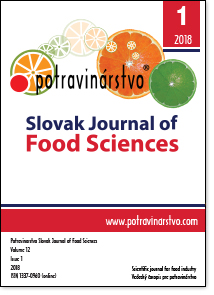Comparison of rheological properties of varietal grape seed oils
DOI:
https://doi.org/10.5219/816Keywords:
grape seeds, grape seed oil, rheology, viscosityAbstract
The aim of this work was to determine the rheological properties of grape seed oils from different varieties selected at different temperatures. Measurement of the rheological properties of grape seed oils was performed on the instrument Anton Paar MCR 102. The rheological properties of the liquid have been performed at temperatures of 0 °C, 15 °C, 30 °C, 45 °C and 60 °C. The density of measured samples ranged from 0.905 ±0.002 to 0.948 ±0.002 g.mL-1. Subsequently, there were determined viscosity values at a shear rate of 5 s-1. As expected, the viscosity decreased with increasing temperature. Highest viscosity values reached grape seed oil of variety Pinot gris where at 0 °C the viscosity reached 0.206 ±0.037 Pa s. Samples measured at 0 °C showed non-Newtonian behavior, while at higher temperatures liquids behave as Newtonian substances. All grape seed oils samples exhibit non-Newtonian behavior at lower temperatures. In experiments carried out at 0 °C, it was observed that the tested samples tends to behave as shear-thinning system with thixotropic properties. At higher temperatures was, in line with other scientific works, observed that samples behave as Newtonian fluids. Knowledge of the rheological properties of oils are very important for their processing, storage, and may affect their quality.
Downloads
Metrics
References
Abramovič, H., Klofutar, C. 1998. The temperature dependence of dynamic viscosity for some vegetable oils. Acta Chimica Slovenica, vol. 45, no. 1, p. 69-77.
Al-Mahasneh, M., Rababah, T. M., Amer, M., Al-Omoush, M., 2014. Modeling physical and rheological behavior of minimally processed wild flowers honey. Journal of Food Processing and Preservation, vol. 38, no. 1, p. 21-30. https://doi.org/10.1111/j.1745-4549.2012.00734.x DOI: https://doi.org/10.1111/j.1745-4549.2012.00734.x
Baudez, J. C. 2006. About peak and loop in sludge rheograms. Journal of Environmental Management, vol. 78, no. 3, p. 232-239. https://doi.org/10.1016/j.jenvman.2005.04.020 PMid:16112796 DOI: https://doi.org/10.1016/j.jenvman.2005.04.020
Baydar, N. G., Akkurt, M. 2001. Oil content and oil quality properties of some grape seeds. Turkish Journal of Agriculture and Forestry, vol. 25, p. 163-168.
Bell, A., Gordon, M. H., Jirasubkunakorn, W., Smith, K. W. 2007. Effect of composition on fat rheology and crystallisation. Food Chemistry, vol. 101, no. 2, p. 799-805. https://doi.org/10.1016/j.foodchem.2006.02.033 DOI: https://doi.org/10.1016/j.foodchem.2006.02.033
Diamante, L. M., Lan, T. 2014. Absolute Viscosities of Vegetable Oils at Different Temperatures and Shear Rate Range of 64.5 to 4835s-1. Journal of Food Processing and Preservation, vol. 2014, 1- 6 p. DOI: https://doi.org/10.1155/2014/234583
Fasina, O. O., Colley, Z. 2008. Viscosity and specific heat of vegetable oils as a function of temperature: 35 °C to 180 °C. International Journal of Food Properties, vol. 11, no. 4, p. 738-746. https://doi.org/10.1080/10942910701586273 DOI: https://doi.org/10.1080/10942910701586273
Frančáková, H., Ivanišová, E., Dráb, Š., Krajčovič, T., Tokár, M., Mareček J., Musilová, J. 2015. Composition of fatty acids in selected vegetable oils. Potravinarstvo, vol. 9, no. 1, p. 538-542. https://doi.org/10.5219/556 DOI: https://doi.org/10.5219/556
Hamm, W., Hamilton, R. J. 2000. Edible Oil Processing. 2nd ed. New York, USA : CRCPress. 342 p. ISBN 978-1-444-33684-9.
Hassanein, M. M., Abedel-Razek, A. G. 2009. Chromatographic quantitation of some bioactive minor components in oils of wheat germ and grape seeds produced as by-products. Journal of Oleo Science, vol. 58, no. 5, p. 227-233. https://doi.org/10.5650/jos.58.227 PMid:19367078 DOI: https://doi.org/10.5650/jos.58.227
Choi, Y., Lee, J. 2009. Antioxidant and antiproliferative properties of a tocotrienol-rich fraction from grape seeds. Food Chemistry, vol. 114, no 4, p. 1386-1390. https://doi.org/10.1016/j.foodchem.2008.11.018 DOI: https://doi.org/10.1016/j.foodchem.2008.11.018
Košmerl, T., Abramovič, H., Klofutar, C. 2000. The rheological properties of Slovenian wines. Journal of Food Engineering, vol. 46, no. 3, p. 165-171. https://doi.org/10.1016/S0260-8774(00)00079-0 DOI: https://doi.org/10.1016/S0260-8774(00)00079-0
Lachman, J., Rutkowski, K., Trávníček, P., Vítěz, T., Burg, P., Turan, J., Junga, P., Višacki, V. 2015. Determination of rheological behaviour of wine lees. International Agrophysics, vol. 29, no. 3, p. 307-311. https://doi.org/10.1515/intag-2015-0036 DOI: https://doi.org/10.1515/intag-2015-0036
Lang, W., Sokhansanj, S., Sosulski, F. W. 1999. Modeling the Temperature Dependence of Kinematic Viscosity for Refined Canola Oil. Journal of the American Oil Chemists´ Society, vol. 69, no. 10, p. 1054-1055. https://doi.org/10.1007/BF02541080 DOI: https://doi.org/10.1007/BF02541080
Opfer, W. B. 1978. Margarine products: a review of modern manufacturing processes. Chemistry and Industry, vol. 18, p. 681-687.
Pyle, D. L., Fryer, P. J., Reilly, C. D. 1997. Chemical Engineering for the Food Industry. 1st ed., London , UK : Springer. 462 p. ISBN 978-1-4615-3864-6.
Rao, M. A. 1999. Rheology of Fluid and Semifluid Foods: Principles and Applications. 2nd ed. USA : Springer. 482 p. ISBN 978-0-387-70930-7.
Rodenbush, C. M. Hsieh, F. H., Viswanath D. D. 1999. Density and Viscosity of Vegetable Oils. Journal of the American Oil Chemists´ Society, vol. 76, no. 12, p. 1415-1419. https://doi.org/10.1007/s11746-999-0177-1 DOI: https://doi.org/10.1007/s11746-999-0177-1
Santos, J. C. O., Santos, I. M. G., Souza A. G. 2005. Effect of heating and cooling on rheological parameters of edible vegetable oils. Journal of Food Engineering, vol. 67, no. 4, p. 401-405. https://doi.org/10.1016/j.jfoodeng.2004.05.007 DOI: https://doi.org/10.1016/j.jfoodeng.2004.05.007
Singh, R. P., Heldman, D. R. 2001. Introduction to Food Engineering. 4th ed. London, UK : Academic Press. 864 p. ISBN 9780080919621.
Steffe, J. F. 1992. Rheological Methods in Food Process Engineering. East Lansing, Mich, USA : Freeman Press. 418 p. ISBN 9780963203618.
Trávníček, P., Krčálová, E., Vítěz T. 2013. Rheopectic Behavior of Rendered Fat. Polish Journal of Environmental Studies, vol. 22, no. 5, p. 1499-1504.
Witczak, M., Juszczak, L., Gałkowska, D. 2011. Non-Newtonian behaviour of heather honey. Journal of Food Engineering, vol. 104, no. 4, p. 532-537. https://doi.org/10.1016/j.jfoodeng.2011.01.013 DOI: https://doi.org/10.1016/j.jfoodeng.2011.01.013
Downloads
Published
How to Cite
Issue
Section
License
This license permits non-commercial re-use, distribution, and reproduction in any medium, provided the original work is properly cited, and is not altered, transformed, or built upon in any way.






























